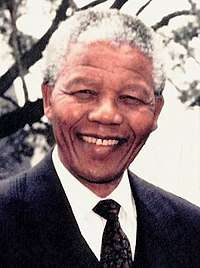Presidency of Nelson Mandela
The presidency of Nelson Mandela began on 10 May 1994, when Nelson Mandela, an anti-apartheid activist, lawyer, and former political prisoner, was inaugurated as President of South Africa, and ended on 14 June 1999. He was the first non-white head of state in South African history, as well as the first to take office following the dismantling of the apartheid system and the introduction of multiracial democracy. Mandela was also the oldest head of state in South Africa's history, taking office at the age of seventy-five.[1]
 | |
| Presidency of Nelson Mandela | |
|---|---|
| 10 May 1994 – 14 June 1999 | |
| President | Nelson Mandela |
| Party | African National Congress |
| Seat | Mahlamba Ndlopfu, Pretoria Genadendal Residence, Cape Town |
| ||
|---|---|---|
|
||
Election
The 1994 general election, held on 27th April, was South Africa's first multi-racial election with full enfranchisement. The African National Congress won a 63% share of the vote at the election, and Mandela, as leader of the ANC, was inaugurated on 10 May 1994 as the country's first Black President, with the National Party's F.W. de Klerk as his first deputy and Thabo Mbeki as the second in the Government of National Unity.[2]
Mandela was sworn in on 11 May 1994.
His inauguration ceremony was attended by 45 heads of state and government, included :



















1995
When Mandela began his term on 10 May 1994, he presided over the transition from minority rule and apartheid, winning international respect for his advocacy of national and international reconciliation.[3]
Mandela encouraged black South Africans to get behind the previously hated Springboks (the South African national rugby team) as South Africa hosted the 1995 Rugby World Cup.[4] (This is the theme of the 2009 film Invictus.) After the Springboks won an epic final over New Zealand, Mandela presented the trophy to captain Francois Pienaar, an Afrikaner, wearing a Springbok shirt with Pienaar's own number 6 on the back. This was widely seen as a major step in the reconciliation of white and black South Africans.[5]
1996
In 1996, Mandela divorced his estranged wife, Winnie Madikizela-Mandela. Thabo Mbeki became the sole deputy president of South Africa in June as a result of F. W. de Klerk's resignation from joint office.
1997
Lockerbie trial
President Mandela took a particular interest in helping to resolve the long-running dispute between Gaddafi's Libya, on one hand, and the United States and UK on the other, over bringing to trial the two Libyans who were indicted in November 1991, and accused of bombing Pan Am Flight 103, which subsequently broke apart and fell to and near the Scottish town of Lockerbie on 21 December 1988, with the loss of 270 lives.[6] As early as 1992, Mandela informally approached President George H.W. Bush with a proposal to have the two indicted Libyans tried in a third country. Bush reacted favourably to the proposal, as did President François Mitterrand of France and King Juan Carlos I of Spain.[7] In November 1994 – six months after his election as president – Mandela formally proposed that South Africa should be the venue for the Pan Am Flight 103 bombing trial.[8]
However, UK Prime Minister John Major flatly rejected the idea saying the British government did not have confidence in foreign courts.[9] A further three years elapsed until Mandela's offer was repeated to Major's successor, Tony Blair, when Mandela visited London in July 1997. Later during the same year, at the 1997 Commonwealth Heads of Government Meeting (CHOGM) at Edinburgh in October 1997, Mandela warned:
"No one nation should be complainant, prosecutor and judge."
1998
In South Africa's first post-apartheid military operation, acting president Mangosuthu Gatsha Buthelezi[10] (who was South Africa's third in command after Nelson Mandela and Thabo Mbeki) ordered troops into Lesotho in September 1998 to protect the government of Prime Minister Pakalitha Mosisili. This came after a disputed election prompted fierce opposition threatening the unstable government.
Also in 1998, Mandela married Graça Machel, the widow of former Mozambican president Samora Machel.
1999
A compromise solution was then agreed for a trial to be held at Camp Zeist in the Netherlands, governed by Scots law, and President Mandela began negotiations with Colonel Gaddafi for the handover of the two accused (Megrahi and Fhimah) in April 1999.[11]
End of term
The 1996 constitution limited the president to two consecutive five-year terms. Mandela did not attempt to have the document amended to remove the two-term limit; indeed, he had only intended to serve one term, age being a strong factor in this decision. Mandela left office on 14 June 1999 . He was succeeded by Mbeki, who was inaugurated to the presidency on 16 June. Mandela retired from active politics, and became, for several years afterward, engaged in a number of philanthropic activities.
Legacy
AIDS/HIV policy
Commentators and critics including AIDS activists such as Edwin Cameron have criticised Mandela for his government's ineffectiveness in stemming the AIDS crisis.[12][13] After his retirement, Mandela admitted that he may have failed his country by not paying more attention to the HIV/AIDS epidemic.[14][15] After that Mandela spoke out on several occasions against the AIDS epidemic.[16][17]
Clothing design
After assuming the presidency, one of Mandela's trademarks was his use of Batik T-shirts, known as the "Madiba shirts", even on formal occasions.[18]
See also
References
- James Morrison (5 December 2013). "Nelson Mandela, South Africa's first black president, dies at age 95". The Washington Times. Retrieved 14 September 2015.
- "Mandela becomes SA's first black president". BBC. 10 May 1994. Retrieved 26 May 2008.
- "The Nobel Peace Prize 1993 – Presentation Speech". Nobelprize.org. Retrieved 28 October 2008.
- "Mandela rallies Springboks". BBC Sport. 6 October 2003. Retrieved 28 October 2008.
- Carlin, John (19 October 2007). "How Nelson Mandela won the rugby World Cup". The Daily Telegraph. UK. Retrieved 28 October 2008.
- Brown, Derek (31 January 2001). "Lockerbie trial: what happened when". The Guardian. London. Retrieved 28 October 2008.
- McGreal, Chris (11 May 1999). "Mandela shies away from global role in retirement". The Guardian. London. Retrieved 28 October 2008.
- "Families say SA trial site acceptable". Dispatch. 27 October 1997. Retrieved 26 May 2008.
- "Mandela's parting shot at Major over Lockerbie". The Guardian. 11 May 1999. p. 13.
- http://www.greenleft.org.au/node/16646
- "Analysis: Lockerbie's long road". BBC. 31 January 2001. Retrieved 26 May 2008.
- Sampson, Anthony (6 July 2003). "Mandela at 85". The Observer. UK. Retrieved 26 May 2008.
- Robinson, Simon (11 April 2007). "The Lion in Winter". TIME. Retrieved 26 May 2008.
- "Can Mandela's AIDS Message Pierce the Walls of Shame?". Peninsula Peace and Justice Center. 9 January 2005. Archived from the original on 26 February 2013. Retrieved 26 May 2008.
- Quist-Arcton, Ofeibea (19 July 2003). "South Africa: Mandela Deluged With Tributes as He Turns 85". AllAfrica.com. Retrieved 26 May 2008.
- "Mandela's stark Aids warning". BBC News. 1 December 2000. Retrieved 23 December 2008.
- Wines, Michael (7 January 2005). "Mandela, Anti-AIDS Crusader, Says Son Died of Disease". NY Times. Retrieved 23 December 2008.
- Khumalo, Fred (5 August 2004). "How Mandela changed SA fashion". BBC. Retrieved 28 October 2008.
_(cropped).jpg)